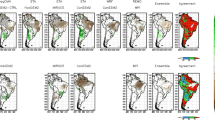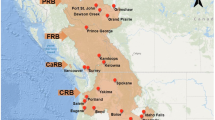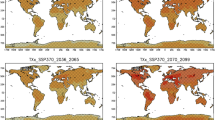Abstract
We analyze changes of four extreme hydroclimatic indices in the RCP8.5 projections of the Phase I CREMA experiment, which includes 21st century projections over 5 CORDEX domains (Africa, Central America, South America, South Asia, Mediterranean) with the ICTP regional model RegCM4 driven by three CMIP5 global models. The indices are: Heat Wave Day Index (HWD), Maximum Consecutive Dry Day index (CDD), fraction of precipitation above the 95th intensity percentile (R95) and Hydroclimatic Intensity index (HY-INT). Comparison with coarse (GPCP) and high (TRMM) resolution daily precipitation data for the present day conditions shows that the precipitation intensity distributions from the GCMs are close to the GPCP data, while the RegCM4 ones are closer to TRMM, illustrating the added value of the increased resolution of the regional model. All global and regional model simulations project predominant increases in HWD, CDD, R95 and HY-INT, implying a regime shift towards more intense, less frequent rain events and increasing risk of heat wave, drought and flood with global warming. However, the magnitudes of the changes are generally larger in the global than the regional models, likely because of the relatively low “climate sensitivity” of the RegCM4, especially when using the CLM land surface scheme. In addition, pronounced regional differences in the change signals are found. The data from these simulations are available for use in impact assessment studies.







Similar content being viewed by others
References
Ballester J, Giorgi F, Rodo X (2010a) Changes in European temperature extremes can be predicted from changes in PDF central statistics. Clim Chang Lett 98:277–284
Ballester J, Rodo X, Giorgi F (2010b) Future changes in central Europe heat waves to mostly follow summer mean warming. Clim Dyn 35:1191–1205
Beniston M et al (2007) Future extreme events in European climate: an exploration ofregional climate model projections. Clim Chang 81:71–95
Coppola E et al. (2014) Present and future climatologies in the Phase I CREMA experiment. Climatic change, this issue
Dickinson RE, Henderson-Sellers A, Kennedy PJ (1993) Biosphere—atmosphere transfer scheme, BATS: version 1E as coupled to the NCAR Community Climate Model. Technical Note NCAR/TN—387 + STR, 72p
Donat MG et al (2013) Updated analyses of temperature and precipitation extreme indices since the beginning of the twentieth century: the HadEX2 dataset. J Geophys Res—Atmos 118:20998–22118
Emanuel KA, Rothman MZ (1999) Development and evaluation of a convection scheme for use in climate models. J Atmos Sci 56:1756–1782
Giorgi F (1991) Sensitivity of summertime precipitation over the western United States to model physics parameterizations. Mon Weather Rev 119:2870–2888
Giorgi F (2014) The Phase I CORDEX RegCM hyper-Matrix (CREMA) experiment. Introduction to the special issue. Climatic Change, this issue
Giorgi F, Mearns LO (1999) Introduction to special section: regional climate modeling revisited. J Geophys Res 104:6335–6352
Giorgi F, Jones C, Asrar G (2009) Addressing climate information needs at the regional level: the CORDEX framework. WMO Bull 175–183
Giorgi F et al (2011) Higher hydroclimatic intensity with global warming. J Clim 24:5309–5324
Giorgi F et al (2012) RegCM4: model description and preliminary tests over multiple CORDEX domains. Clim Res 52:7–29
Grell GA (1993) Prognostic evaluation of assumptions used by cumulus parameterizations. Mon Weather Rev 121:764–787
Huffman GJ et al (2001) Global precipitation at one-degree daily resolution from multi-satellite observations. J Hydrometeorol 2:36–50
Huffman GJ et al (2007) The TRMM multisatellite precipitation analysis (TMPA): Quasi-global, multiyear, combined-sensor precipitation estimates at fine scale. J Hydrometeorol 8:38–55
IPCC (2012) In: Field CB, Barros V, Stocker TF, Qin D, Dokken DJ, Ebi KL, Mastrandrea MD, Mach KJ, Plattner G-K, Allen SK, Tignor M, Midgley PM (eds) Managing the risks of extreme events and disasters to advance climate change adaptation. A special report of Working Groups I and II of the Intergovernmental Panel on Climate Change. Cambridge University Press, Cambridge, p 582
Kjellstrom E et al (2007) Modeling daily temperature extremes: recent climate and future changes over Europe. Clim Chang 81:249–265
Lenderink G (2010) Exploring metrics of extreme daily precipitation in a large ensemble of regional climate model simulations. Clim Res 44:151–166
Meehl GA et al (2007) In: Solomon S (ed) Global climate projections, chapter 10 of climate change 2007, The physical science basis, WGI contribution to the fourth assessment report of the intergovernmental panel on climate change (IPCC). Cambridge University Press, New York, pp 747–845
Moss RH et al (2010) The next generation of scenarios for climate change research and assessment. Nature 463:747–756
Nikulin G et al (2012) Precipitation climatology in an ensemble of CORDEX Africa regional climate simulations. J Clim 25:6057–6078
Oleson K et al (2008) Improvements to the community land model and their impact on the hydrological cycle. J Geophys Res 113, G01021. doi:10.1029/2007JG000563
Pal JS et al (2007) The ICTP RegCM3 and RegCNET: regional climate modeling for the developing world. Bull Am Meteorol Soc 88:1395–1409
Seneviratne SI et al (2006) Land-atmosphere coupling and climate change in Europe. Nature 443:205–209
Sillmann J, Kharin VV, Zwiers FW, Zhang X, Bronaugh D (2013) Climate extreme indices in the CMIP5 multimodel ensemble: Part 2. Future climate projections. J Geophys Res—Atmos 118:2473–2493
Taylor KE, Stouffer RJ, Meehl GA (2012) An overview of CMIP5 and the experiment design. Bull Am Meteorol Soc 78:485–498
Tebaldi C, Hayhoe K, Arblaster JM, Meehl GA (2006) Going to the extremes: an intercomparison of model-simulated historical and future changes in extreme events. Clim Chang 79:185–211
Trenberth KE (1999) Conceptual framework for changes of extremes of the hydrological cycle with climate change. Clim Chang 42:327–339
Acknowledgments
This work was partially supported by grants from the project NextDATA funded by the Italian Consiglio Nazionale della Ricerca (CNR).
Author information
Authors and Affiliations
Corresponding author
Additional information
This article is part of a Special Issue on “The Phase I CORDEX RegCM4 Experiment MAtrix (CREMA)” edited by Filippo Giorgi, William Gutowski, and Ray W. Arritt.
Rights and permissions
About this article
Cite this article
Giorgi, F., Coppola, E., Raffaele, F. et al. Changes in extremes and hydroclimatic regimes in the CREMA ensemble projections. Climatic Change 125, 39–51 (2014). https://doi.org/10.1007/s10584-014-1117-0
Received:
Accepted:
Published:
Issue Date:
DOI: https://doi.org/10.1007/s10584-014-1117-0




